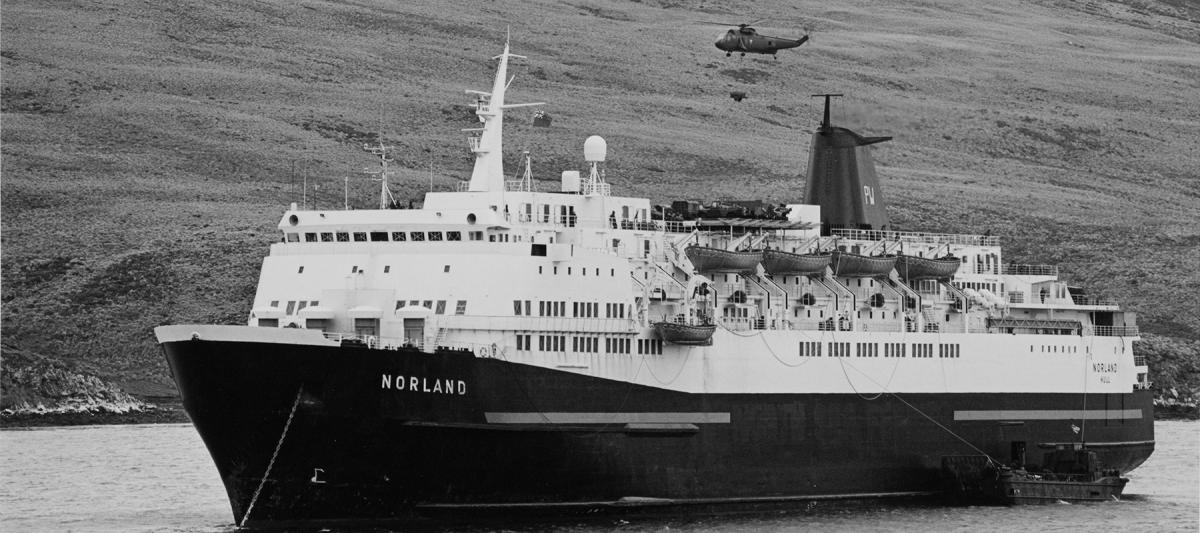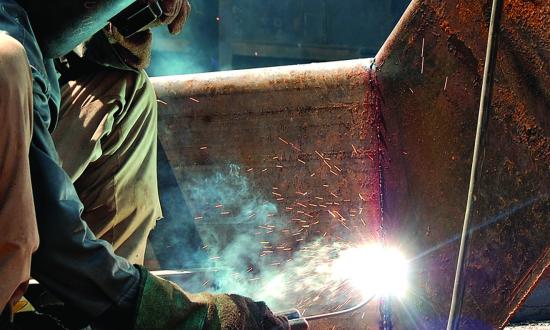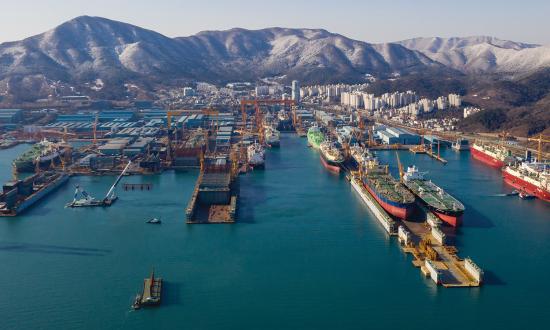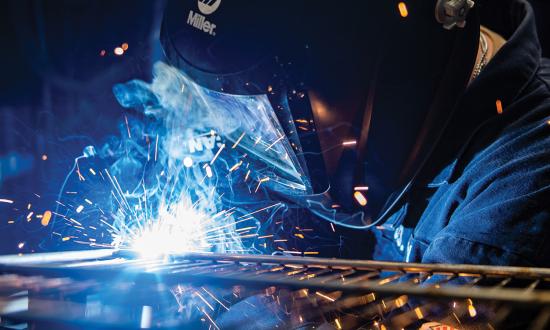In 1982, the Royal Navy was thrust into one of the most complex naval campaigns since World War II. Following the 1981 Defence White Paper, the Royal Navy and Royal Fleet Auxiliary (RFA) were actively divesting the assets needed to conduct expeditionary warfare operations. With the outbreak of the Falklands War less than a year later, the British had to create a logistics chain by converting commercial vessels to military uses. These “ships taken up from trade” (STUFT) supported a critical logistics chain more than 8,000 miles long, filling in essential capability gaps.
In the near future, the United States may find itself in a similar position. A conflict against China would stress the capabilities of the Navy’s fleet architecture, especially its logistical support capacity. Unable to surge construction with an under resourced industrial base, new vessels will not replace battle losses for years, let alone expand the fleet to a wartime footing. While commercial ship conversions are an imperfect solution, they would provide badly needed capabilities. Under wartime conditions, the Navy would need to assume the higher risk their use entails.
Conversation and Modification
It is important to note that because of the seasonal weather in the South Atlantic, the British Task Force had to be assembled and under way within weeks, limiting the time available for shipyard conversion. With the longest STUFT conversion lasting only 16 days, the hasty effort led to imperfect designs.1 However, unlike the Royal Navy in 1982, the U.S. Navy today has sufficient fleet architecture to support immediate expeditionary operations upon the outbreak of conflict.
The U.S. Navy should take a more measured approach than the understandably rushed United Kingdom effort. Taking more time to convert commercial vessels to military use—a few months at a time—would allow for greater military optimization of the vessels. During the planning to convert the Contender Bezant into an aircraft ferry, the decision was made to halve the conversion period from 10 to 5 days.2 This left the ship able to hold only 11 aircraft on its deck, sheltered underneath shipping containers. With an extra five days, the Contender Bezant might have been able to use her deck cargo hatch as an aircraft elevator, increasing aircraft capacity and operational flexibility.3 Even a small delay in conversion work can result in significant increases in military capability.
British STUFT conversions consumed a vast quantity of naval stores and highlighted the many modifications needed for a commercial vessel to have military utility. Everything from internal sound-powered telephones, emergency lighting, generators, reverse-osmosis water purification facilities, damage control equipment, and signal equipment needed to be installed on STUFTs.4 In addition to physical modifications, modern vessel conversions would require cyber hardening or removal of vulnerable commercial systems and the installation of military network accessibility.
Many vessels are simply not suited for conversion. Of the ships inspected by the Royal Navy in the Falklands War, only one in four was considered suitable for military use.5 Commercial vessels should be selected for conversion based on system similarity to reduce the complexity of repairs and other logistical requirements.
However, the technical requirements for modification are not complex. The Navy could conduct conversion work using small commercial shipyards engaged in construction, repair work, and vessel alterations outside of the traditional defense industrial base.6 As an example, the addition of flight decks, structural stiffening, and refueling at sea modifications are processes involving structural fabrication techniques familiar to commercial shipyards. Outsourcing commercial conversion work allows of the traditional industrial base to focus on their critical efforts to surge purpose-built combatant construction.
Training and Operation
The training and operation of converted vessels without using civilian crews will be difficult. Even if vessels are structurally modified and equipped for military operations, operational use may be a complex challenge. Procedures will need to be developed concurrently while vessels are being modified for military service.
Converted commercial vessels are less capable of surviving and performing successful damage control than their purpose-built contemporaries. In his wartime diary, Rear Admiral Sandy Woodward, the British Task Force Commander, noted his concern with the passenger liner Canberra, that “with her totally inadequate damage-control and fire-fighting arrangements, [Canberra] is a floating bonfire awaiting a light.”7 The sinking of the Atlantic Conveyor in the Falklands War is also worth remembering. Hit by at least one Exocet antiship missile, the Atlantic Conveyor, a converted roll-on/roll-off container ship, was sunk with valuable stores and aircraft onboard. The ship was not armed, nor did she have electronic countermeasures, chaff, or other decoys.8 Every other vessel in her vicinity was able to launch chaff decoys.9
The Atlantic Conveyor’s commercial design hindered her ability to perform effective damage control. Without watertight longitudinal or transverse bulkheads, she was vulnerable to fire and flooding.10 In addition, her mixed crew of merchant mariners and Royal Navy personnel had different training standards and practices for damage control.11 A limited number of sound-powered telephones combined with catastrophic damage to the commercial shipboard address system made coordinating an effective response too difficult.12 After remaining afloat for three days, the Atlantic Conveyor sank under tow.
Converted commercial vessels in Navy service would necessitate the development of new damage control plans. Modifications to vessels should include the establishment of fire zones when possible and the addition of system redundancy when feasible. The installation of damage control equipment lockers would improve Navy personnel’s familiarity with the vessels. The conversion of a space to a damage control central station and the installation of sound-powered telephones are simple ways to ensure communication.
Personnel and Support Roles
The Navy already faces a shortage of around 9,000 sea billets. Likewise, the Merchant Marine has a deficit of more than 1,800 qualified mariners, making manning converted commercial vessels a challenge—even if the Navy could expand its personnel strength under wartime conditions. Unlike the British, who brought civilian mariners under the jurisdiction of the Naval Discipline Act, the United States may face legal challenges using civilian mariners, even in combat support roles.13 Allowing civilian mariners to join the Navy at the outbreak of conflict without going to basic training could be a partial solution. A pool of qualified personnel, like those able to operate the many midsized vessels in the U.S. offshore energy industry, could operate familiar equipment. Just as with the STUFT vessels, these crews would need to be augmented by naval personnel with expertise in naval operations, damage control, medicine, and military logistics.14
In the Falklands War, 15 STUFT tankers provided fuel and water for the Royal Navy Task Force, augmenting 14 dedicated Royal Fleet Auxiliary (RFA) ships.15 Tanker conversions are relatively simple, but their most significant operational limitation is their reduced fuel delivery rate. The British circumvented this limitation by having STUFT tankers support dedicated RFA fleet oilers.16
Commercial roll-on/roll-off vessels and other vessel types converted for amphibious support could provide the additional sealift needed to support expanded combat operations. In the Falklands War, “[STUFT] shipping accounted for the movement of 9,000 personnel and 100,000 tons of material.” Converted amphibious vessels could provide extra capacity but would be challenging to disembark from under combat conditions with their optimization for pierside logistics.
The cruise ship Queen Elizabeth II was able to carry 3,000 troops of 5 Brigade to the Falklands, but the internal arrangements of the passenger liner’s holds meant that she never fully unloaded her valuable stores during the war.17 In San Carlos Water, some STUFT roll-on/roll-off vessels were unable to connect with Royal Navy mexeflote landing rafts because of high clearances between the loading ramps of the ferries and the rafts.18 On average, commercial ships could unload 20 tons per hour, compared to 90 tons per hour from purpose-built amphibious ships.19 The use of STUFTs for amphibious lift in the Falklands resulted in mixed success. While these vessels gave the United Kingdom the capacity to move personnel and supplies to the Falklands, their rapid conversion and hasty manning hindered their use as amphibious lift.
In hindsight, these challenges could have been mitigated by developing procedures concurrently with small modifications to converted vessels. Conversions should include improvements to shipboard public address systems and structural modifications to standardized loading and unloading procedures. Modern improvements such as digitized records would be critical to understanding where stores are located internally.
Developing tactical loading plans would ensure that stores and personnel can disembark even in austere conditions without traditional port infrastructure. Disembarkation training for personnel assigned to converted commercial vessels should occur before deployment. In the Falklands War, Royal Marines and paratroopers received only one day and one night per battalion for disembarkation rehearsals from STUFT vessels, leading to challenges moving from ship to shore in San Carlos Water.20 Developing training procedures for personnel assigned to converted vessels would mitigate these risks.
Combat Operations
Advances in technology also enable converted commercial vessels to directly participate in naval combat operations. A modern aircraft ferry could support unmanned aerial vehicle (UAV) and unmanned underwater vehicle (UUV) operations ranging from intelligence, surveillance, and reconnaissance to antisubmarine warfare. The proliferation of both civilian and military underwater infrastructure has amplified the importance of the sub-sea domain. Converted cable laying and exploration ships could use UUVs and commercial equipment to support seabed warfare operations.
Start Early
The maturation of autonomy would enable the conversion of commercial ships into unmanned surface vessels. The Navy’s current USV prototypes, the Ranger and the Nomad, are themselves converted offshore supply vessels from the oil industry. Arming such ships with containerized launchers could expand the fleet’s magazine depth, demonstrated when the Ranger fired an SM-6 in 2021. In these roles, lightly manned vessels could provide combat support to traditional surface combatants. This support would be a needed force multiplier as the traditional surface combatant fleet endures potentially significant combat losses.
The Falklands War offers the last significant operational use of commercial vessels for military purposes, one China clearly has studied. In 2015, the China Classification Society changed its rules to ensure that new tanker, break bulk, roll-on/roll-off, bulk carrier, and container ships would be built with the ability to support military operations with minimal modification. Far from a hypothetical capability, Chinese military units have actively rehearsed using civilian vessels in military operations under the doctrinal banner of military-civil fusion. China practiced launching assault craft from a ferry in 2022 and using a heavy lift ship as a helicopter carrier in 2021. Commercial vessels supported Chinese military operations and exercises 38 times from October 2021 to September 2022. This civil-military fusion cannot be replicated outside of an authoritarian state, but it is indicative of the lasting utility of commercial vessels in the forty years since the Falklands War.
Looking Forward
Commercial ship conversions are not an alternative to maintaining a well-balanced and resilient fleet architecture of purpose-built vessels. The U.S. Navy should continue to focus on building a balanced fleet of survivable support, amphibious, and combatant ships. However, converted commercial ships could be a useful tool to replace losses and expand the fleet to a wartime footing in the event of a future conflict. China is already openly embracing similar options. The Navy must plan for a methodical conversion of commercial ships and not relearn the hard-earned lessons the United Kingdom experienced in 1982.
1. Rodger Villar, Merchant Ships at War: The Falklands Experience (Annapolis, MD: U.S. Naval Institute Press, 1984), 109.
2. Villar, Merchant Ships at War, 181.
3. Villar, 181.
4. Villar, 26–28.
5. Kenneth L. Privratsky, Logistics in the Falklands War (UK: Pen & Sword Military, 2017), 30.
6. Maritime Administration (MARAD), The Economic Importance of the U.S. Private Shipbuilding and Repairing Industry (30 March 2021), 6
7. Sandy Woodward and Patrick Robinson, One Hundred Days: The Memoirs of the Falklands Battle Group Commander (Annapolis, MD: U.S. Naval Institute Press, 1997), 237.
8. British Royal Navy, Board of Inquiry Report: Loss of SS Atlantic Conveyor (21 July 1982), A-1 A-7.
9. Max Hastings and and Simon David Jenkins, The Battle for the Falklands (London: Pan Books, Cop, 1997), 227.
10. British Royal Navy, Board of Inquiry Report: Loss of SS Atlantic Conveyor, F-1.
11. British Royal Navy, Board of Inquiry Report: Loss of SS Atlantic Conveyor, 3–5.
12. British Royal Navy, Board of Inquiry Report: Loss of SS Atlantic Conveyor, A-5.
13. Villar, Merchant Ships at War, 15.
14. Villar, 14.
15. Villar, 12.
16. Villar, 53.
17. Privratsky, Logistics in the Falklands War, 154–55.
18. Privratsky, 50.
19. Privratsky, 50.
20. Privratsky, 78–79.






